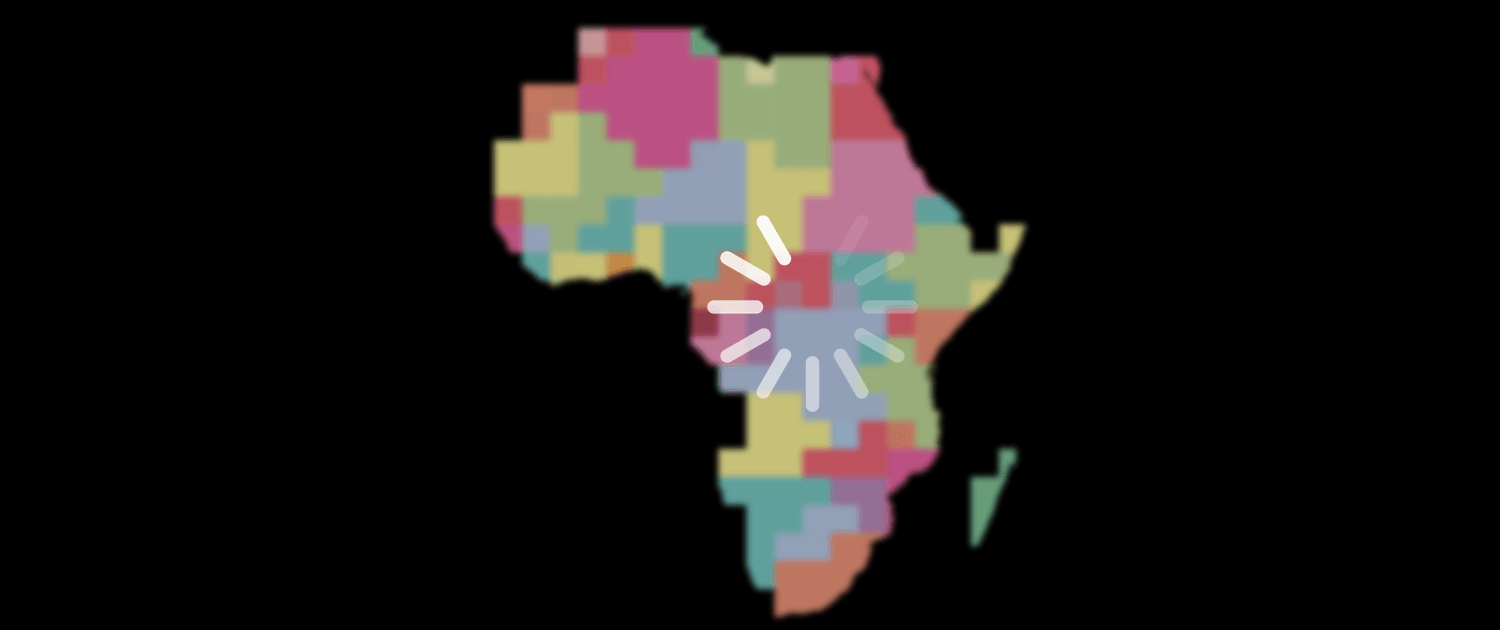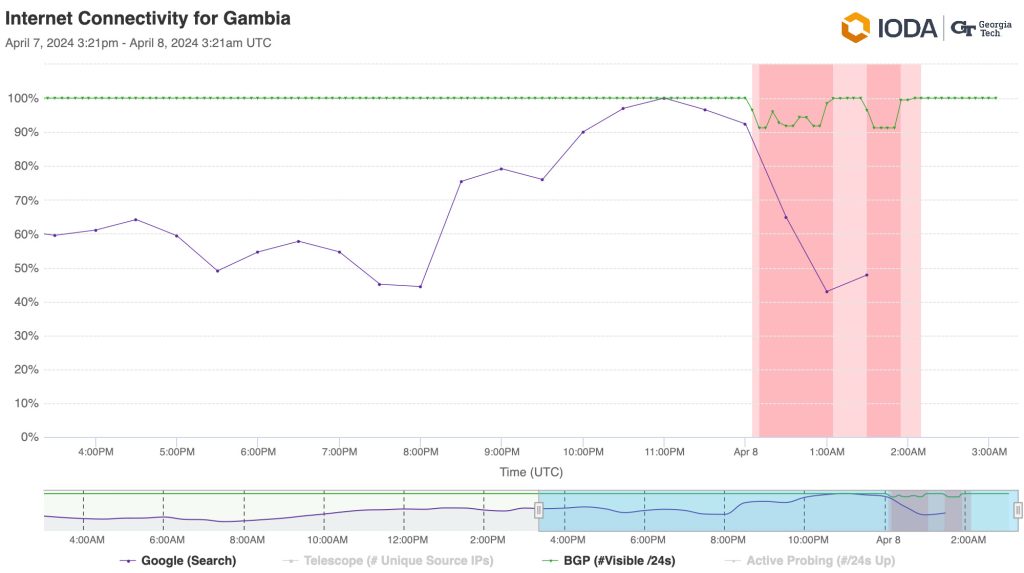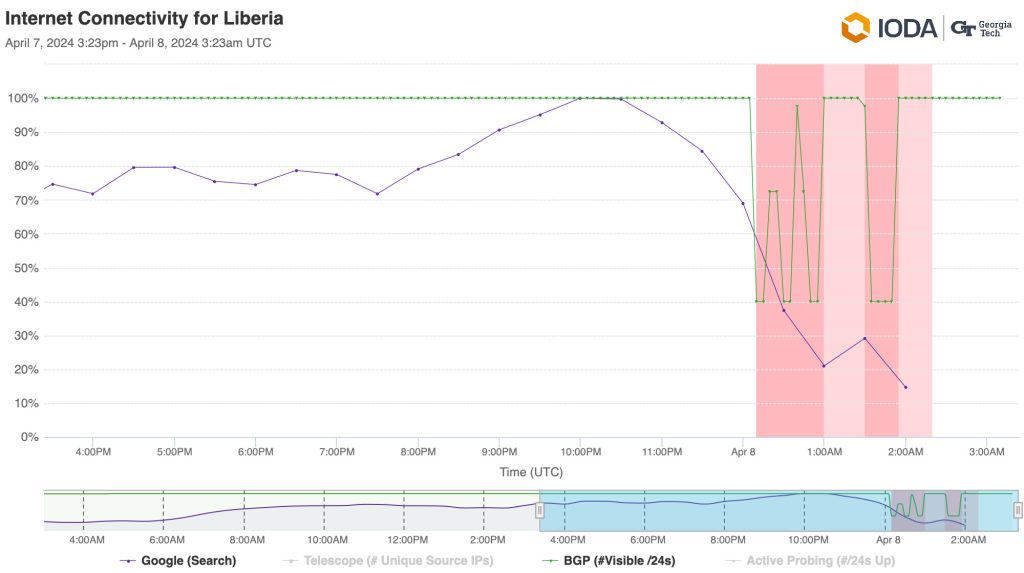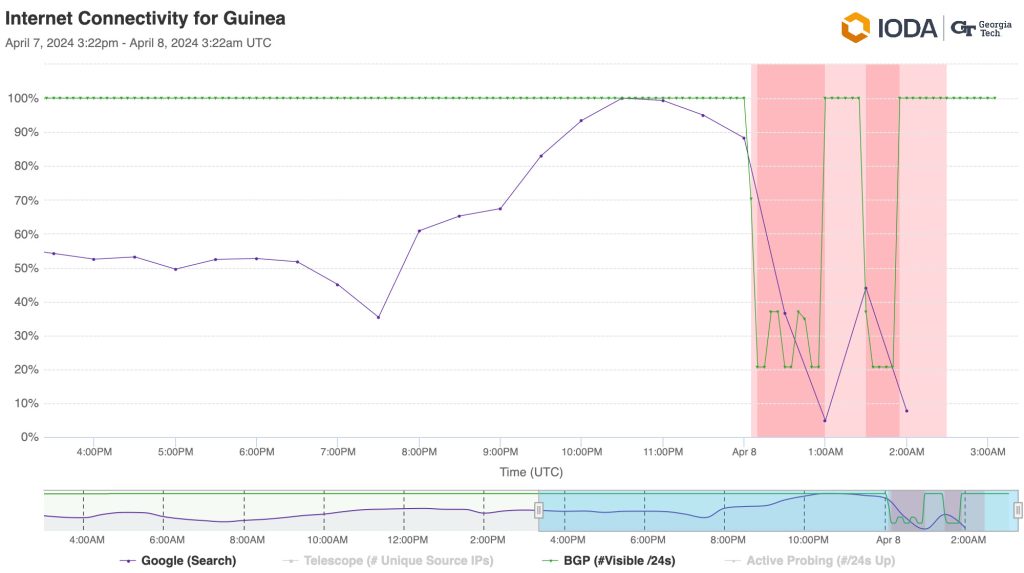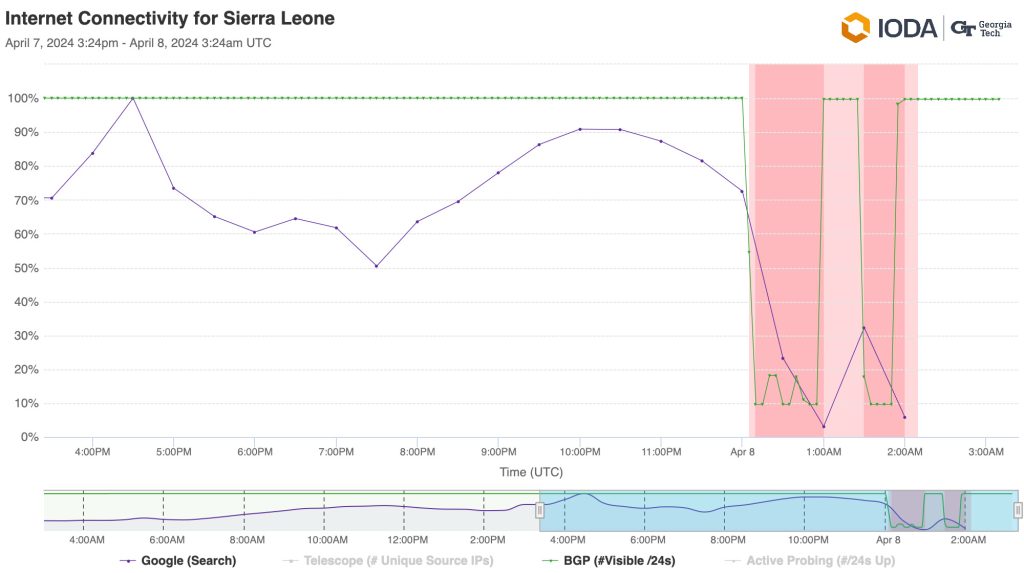UPDATE—18 April 2024—Read our 2024 West Africa Submarine Cable Outage Report for a full after-event analysis.
Across the Internet measurement community today, we’ve been watching the outages that are unfortunately happening across much of western and southern Africa. The outages are very clear and substantial in reports from Cloudflare Radar and the Internet Outage Detection and Analysis (IODA), as the screenshots below indicate.
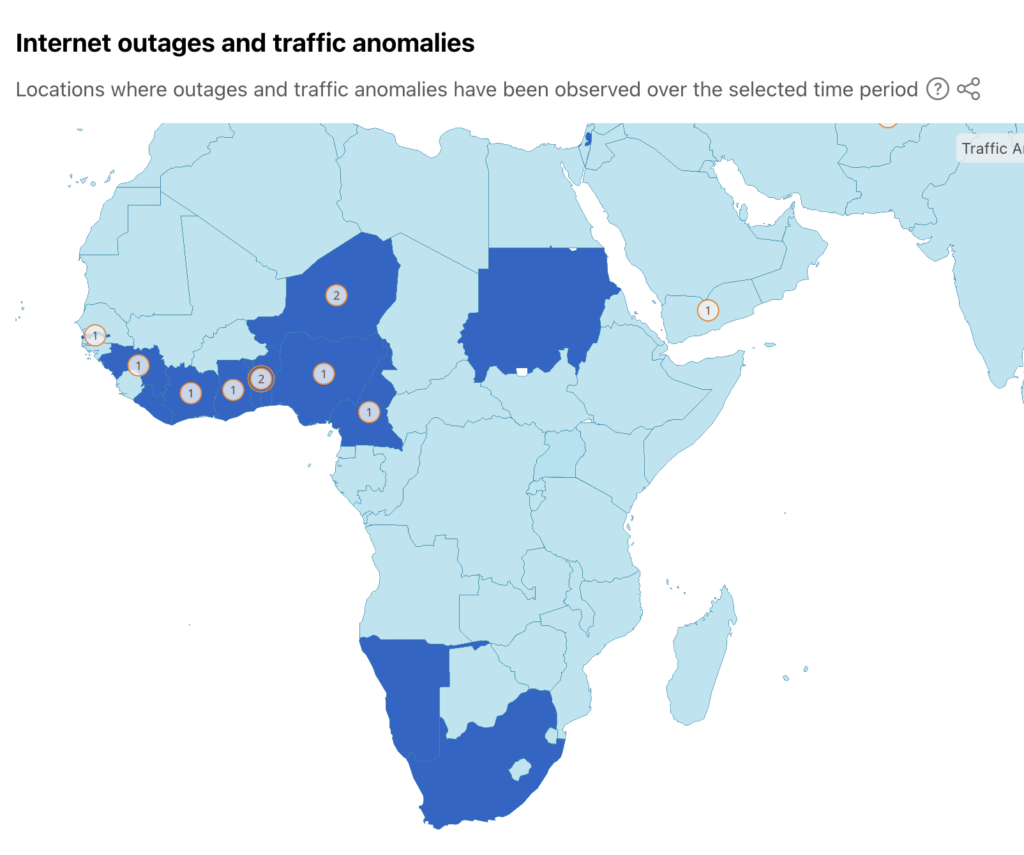
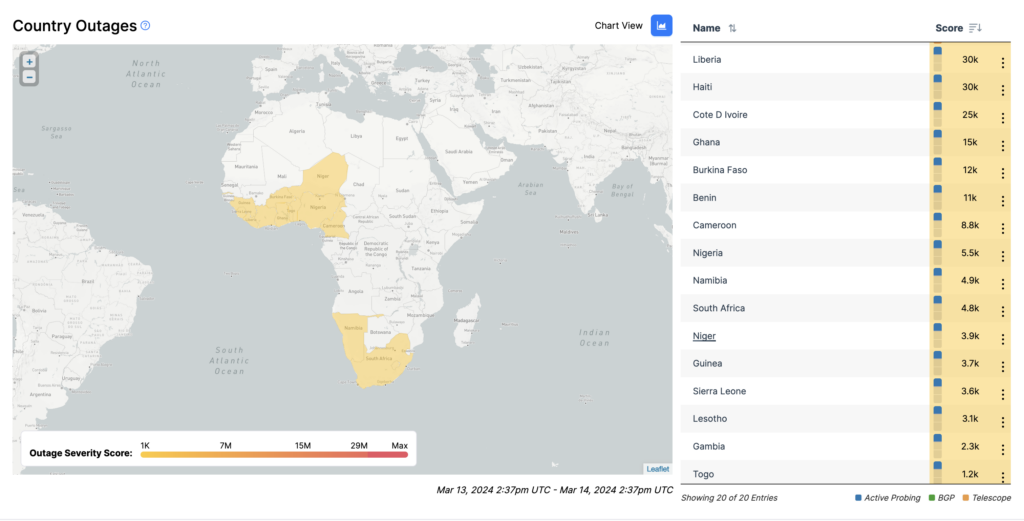
Cloudflare has published a blog post on more of what they have seen so far.
The general understanding at this time is that the outages relate to reduced capacity within the subsea cables connecting these regions of Africa to the rest of the global Internet.
Earlier today network operator Vodacom posted on X that an undersea cable was to blame. MTN Nigeria posted a similar message, as did other Internet and telecom providers in the region.
Microsoft Azure’s status site stated which undersea cables Microsoft had been able to determine were having issues:
We have determined that multiple fiber cables on the West Coast of Africa — WACS, MainOne, SAT3, ACE — have been impacted which reduced total capacity supporting our Regions in South Africa.
In addition to these cable impacts, the on-going cable cuts in the Red Sea — EIG, Seacom, AAE-1 — are also impacting capacity on the East Coast of Africa.
This combination of incidents has impacted all Africa capacity – including other Cloud providers and public Internet as well.

A Cable Cut? Or Capacity Issues? Or Misconfiguration?
The challenge we all have right now is not having enough information to understand what is happening here.
Were there cuts to more cables (possibly by an undersea rock slide)? Or were there configuration issues? We need transparency from the cable and network operators so that we all can understand what is going on.
Today’s events highlight rather dramatically why we believe resilience is so important in Internet connectivity.
We will continue to monitor this situation and provide more analysis as soon as possible.
[Update 14 March 23:00 UTC]
Restoration Could Take A Week to Repair, Côte d’Ivoire
According the Côte d’Ivoire Digital Transformation Head, Olivier Avoa, four of the five subsea cables connected to Côte d’Ivoire are suspected to be damaged with restoration expected to take up to a week. Only Moov Africa Côte d’Ivoire (AS 37190) is supporting all operator traffic.

[Update 15 March 7:00 UTC]
Some Countries Regaining Full Capacity
Of the 12 countries reportedly affected by the outage, the majority seem to have restored Internet traffic volume to levels seen the previous 24 hours, according to Cloudflare Radar.
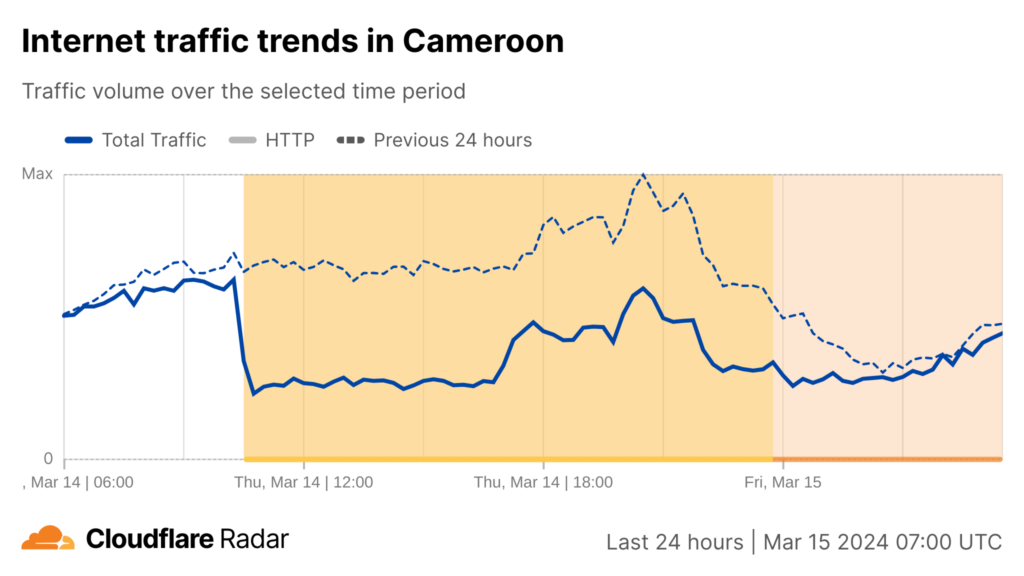
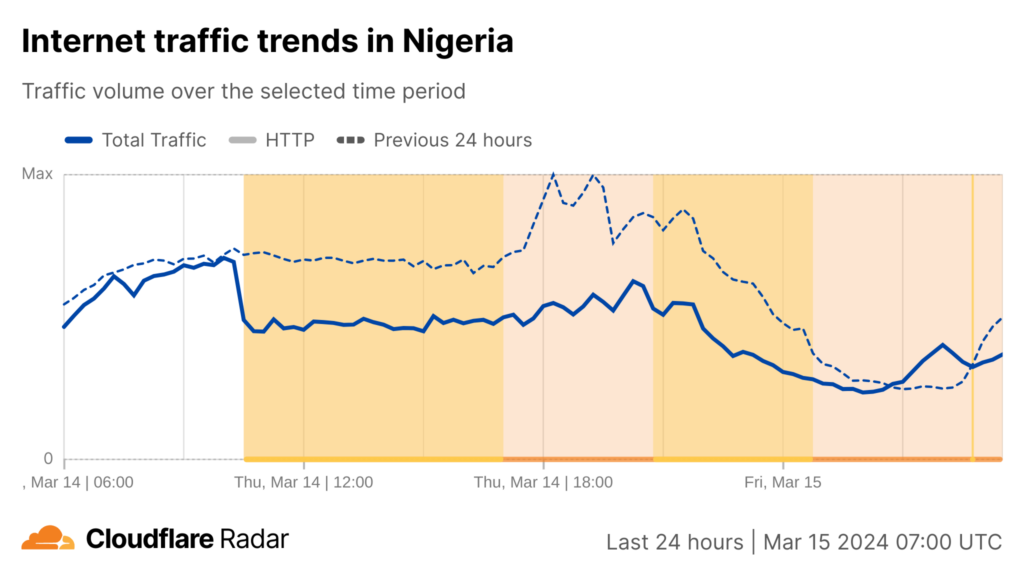
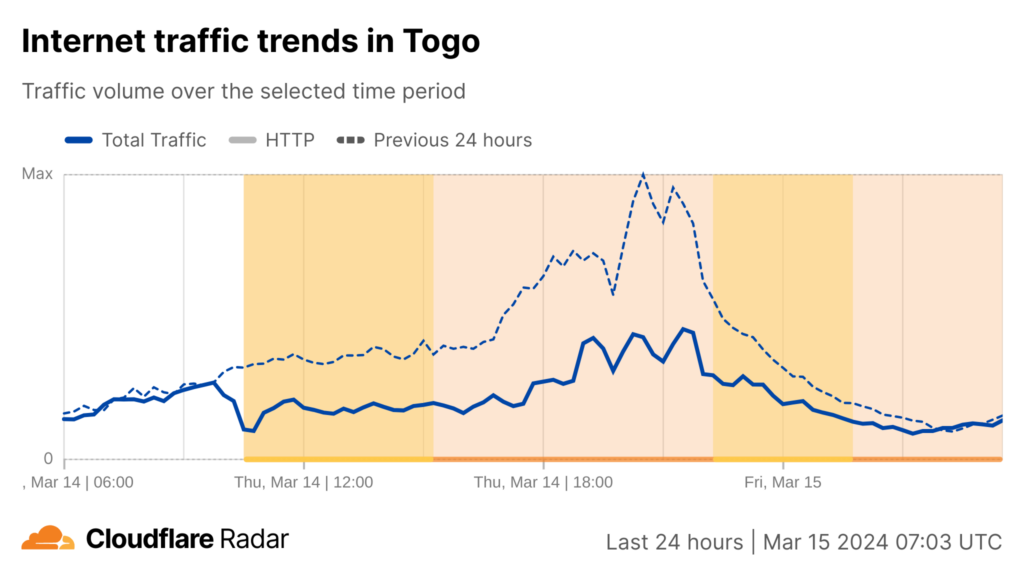
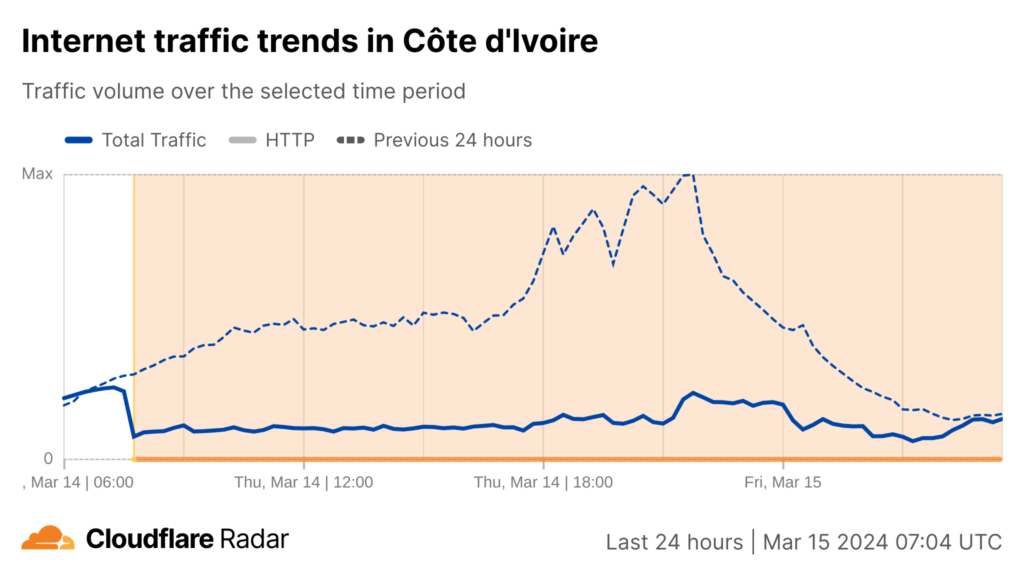
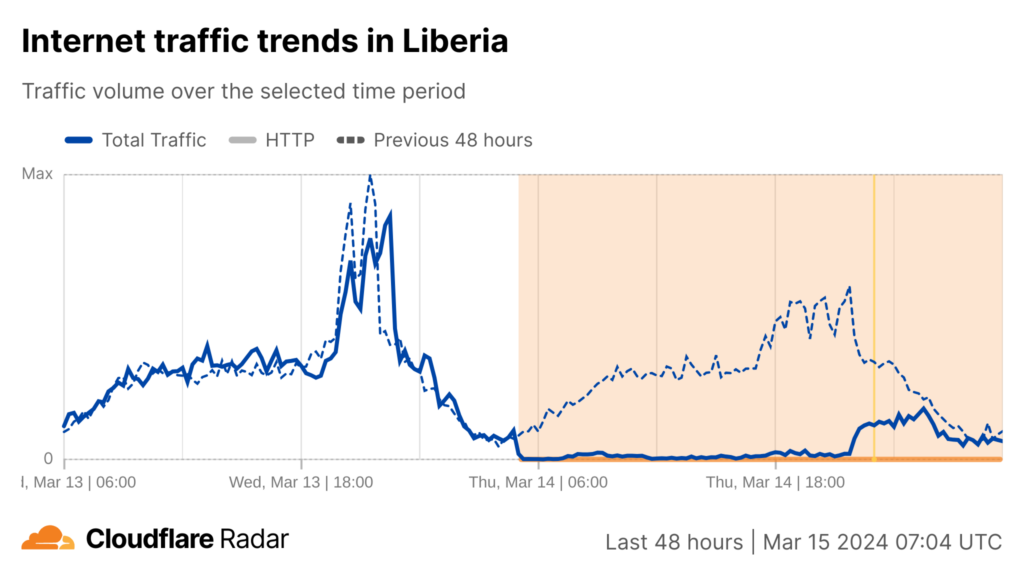
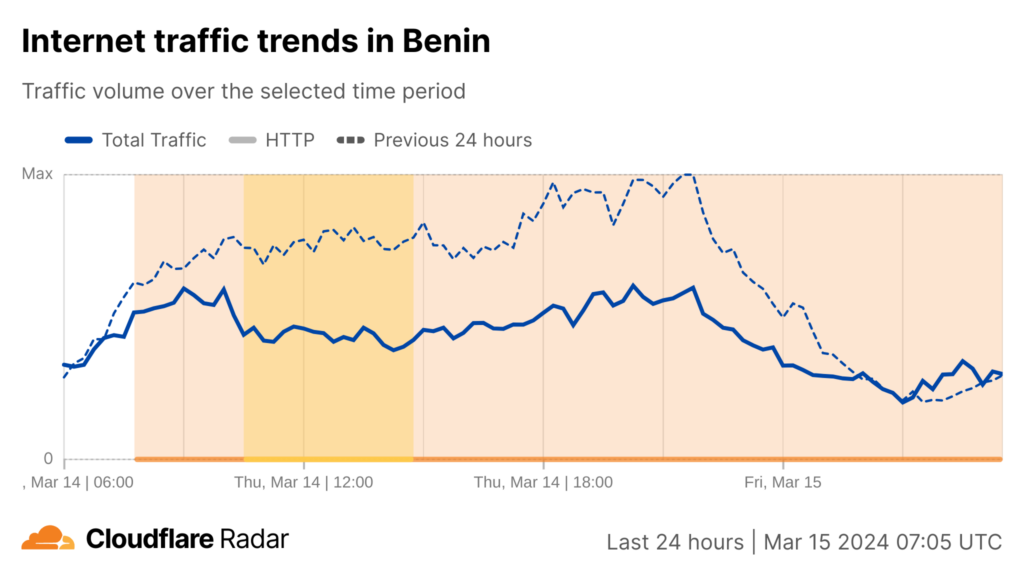
Although Cloudflare Radar is still reporting an outage for South Africa the effects have not been as great as other countries, which can possibly be credited to their greater overall Internet resilience and greater number of subsea cables (n=9).
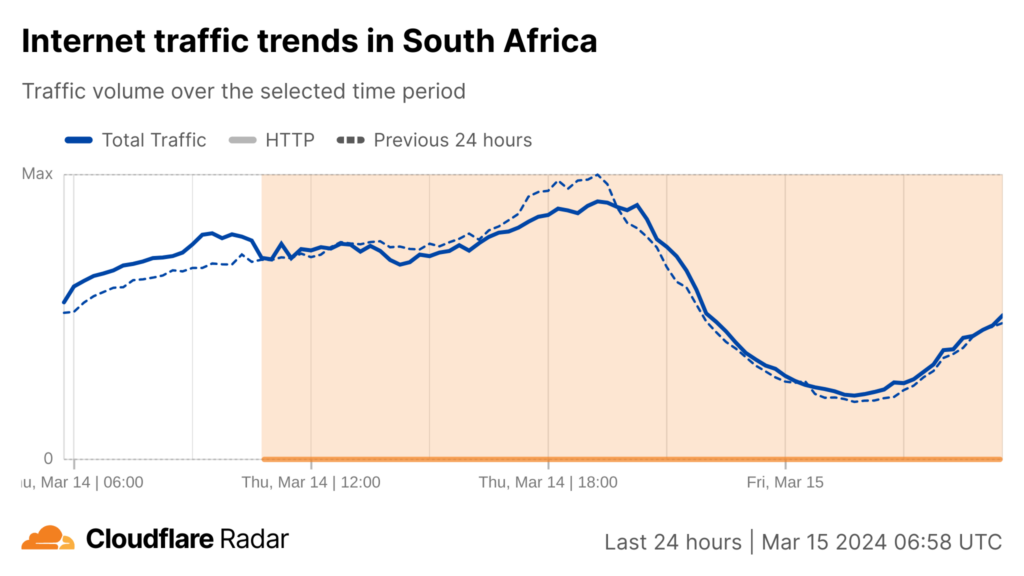
Four countries — Gambia, Guinea, Namibia, and Niger — experienced relatively smaller outages compared to the neighbouring countries, with all recovering within 1-3 hours.
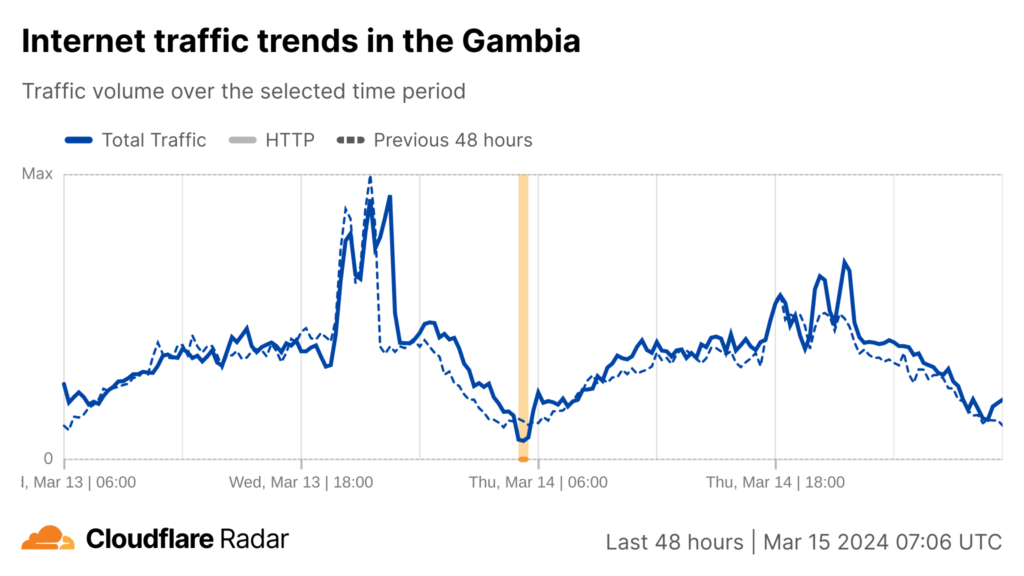
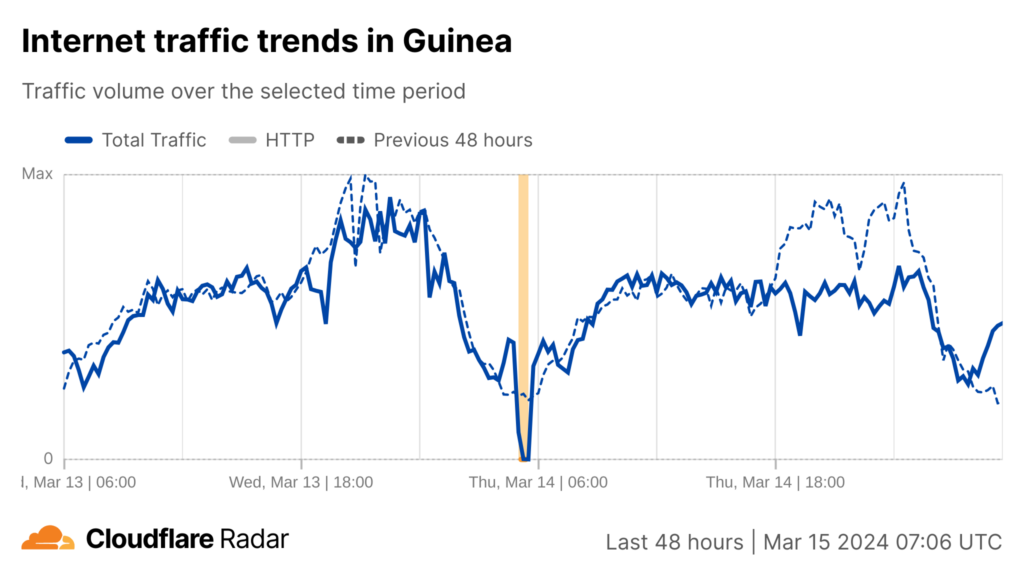
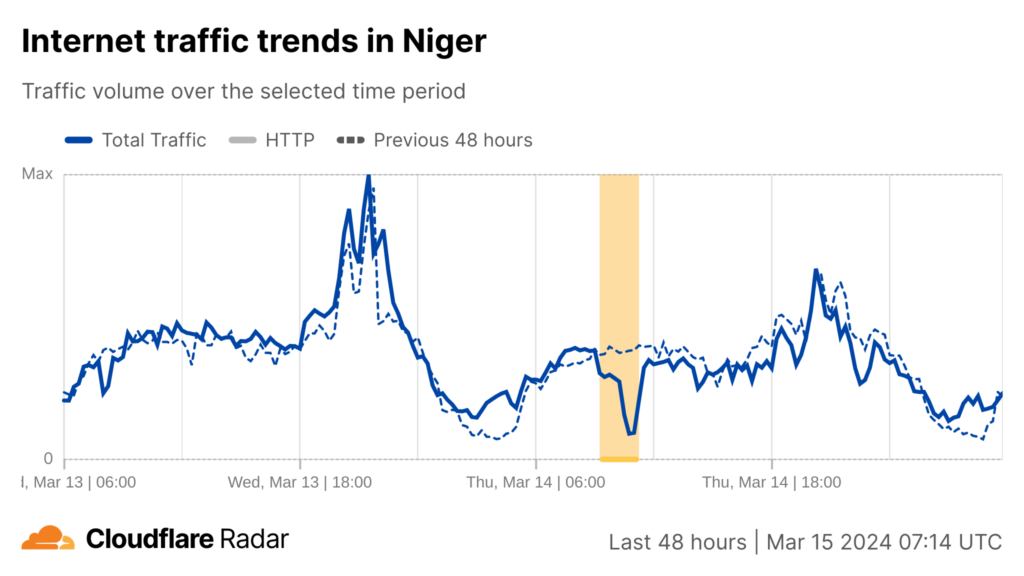
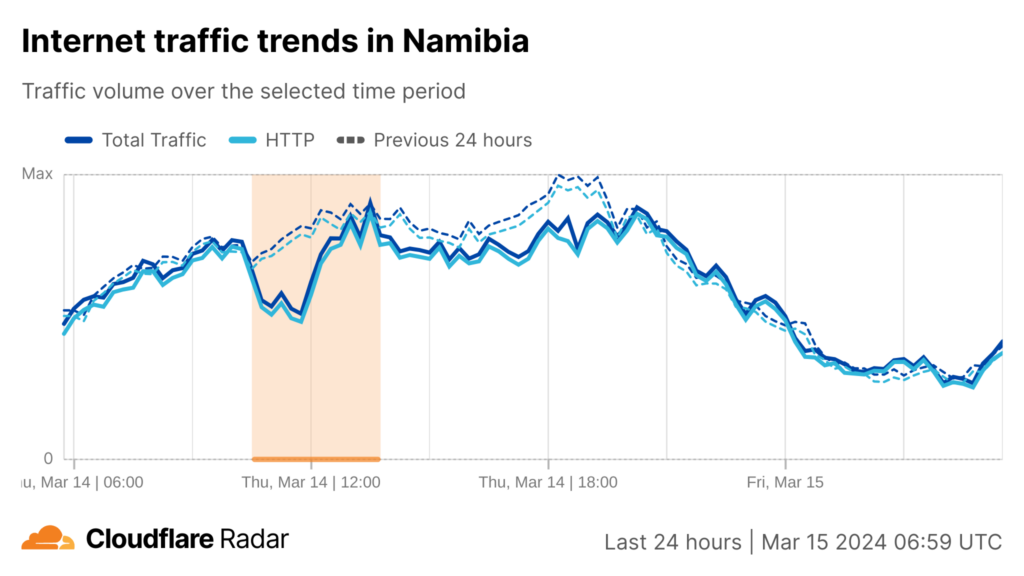
Ghana seems to be still the worst effected country from the outage with traffic trends more than a third of what they were 24 hours earlier.
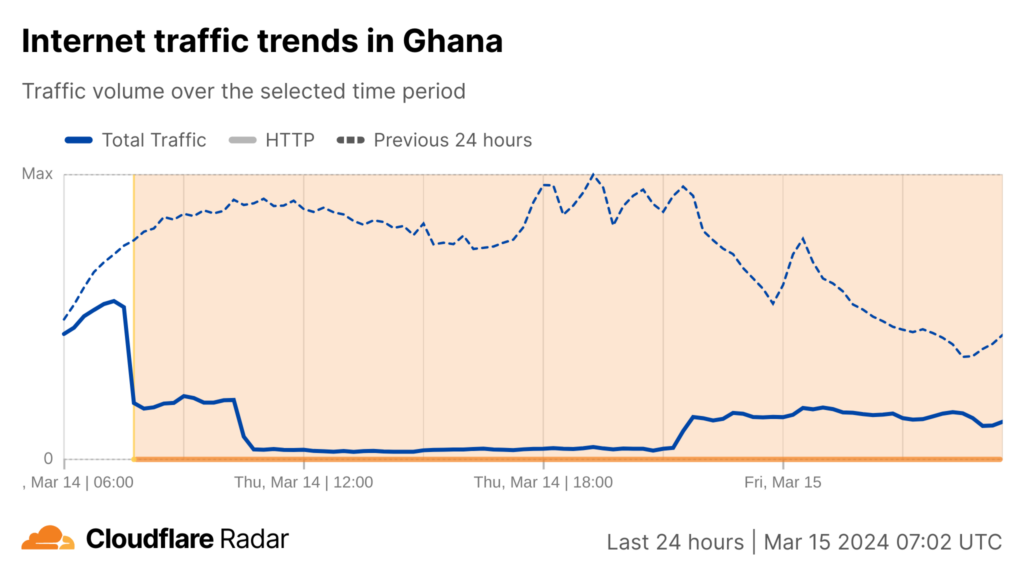
[Update 15 March 21:00 UTC]
Local Advocacy Efforts Supporting Internet Users
The Internet Society Cameroon Chapter released the following statement regarding the impact of the outages and how people can help ration the limited bandwidth:
[Update 18 March]
Togo Equiano Cable Increasing Capacity to Support Neighbors. MainOne Provides Update
As reported by Capacity, CSquared, which manages the Equiano cable that serves Togo, has increased its capacity by x4 and has been working with carriers across Africa to address the outages, including providing capacity across its terrestrial cross-border fiber network with Ghana and Benin.
“We expect that lessons will be learnt and these routes will be used for diversity permanently.”
Lanre Kolade, CEO of CSquared VIA Capacity
Exclusive: 4x increase in traffic at Equiano's Togo CLS
— Capacity Media (@capacitymedia) March 18, 2024
Lanre Kolade, the CEO of the company that manages the Equiano cable landing station in Lome, Togo, says his firm is providing an additional 300G since the faults to other cables serving West Africahttps://t.co/OjXqHBXeN5
Meanwhile, MainOne, a West African data center and connectivity solutions provider, with a presence in Nigeria, Ghana, and Côte d’Ivoire, released a statement that it is working with regional partners to reroute traffic for its customers.
Update on Submarine Cable Outage: West Africa Remains Open for Business pic.twitter.com/qdG8FFDAZB
— MainOne (an Equinix Company) (@Mainoneservice) March 18, 2024
[Update 19 March]
Repair Ships are on the Way
Ben Roberts, Group Chief Technology and Innovation Officer at Liquid Intelligent Technologies in Kenya has told Pulse that the position of the “WACS, SAT3, Mainone, and ACE [subsea cables] cuts are slightly west of Abidjan branch “and that they are the result of “what looks like a [undersea] rockfall”. He adds, “It’s widely believed that ship CS Sovereign from the UK will attend to two faults, and CS Leon Thevinin from Capetown will attend to the other two.”
Africa Submarine Cable Situation Report – 14/3/24
— Ben Roberts 🇬🇧🇰🇪 (@benliquidkenya) March 14, 2024
Situation is Very bad.
East Coast of Africa to Europe
Seacom/TGN – Cut
AAE1 – Cut
EIG – Cut
All cut in Red Sea
West Coast of Africa to Europe
WACS – Fault
Mainone – Down
ACE – Fault
SAT3-Down
Faults near Abidjan
[Update 20 March]
Africa Resilience has Come a Long Way
Steve Song, Policy Advisor at Mozilla Corporation, has noted that the outage could have been a lot worse if not for all the “incredible resilience that has emerged in the last 15 years thanks to investment in a host of undersea cables”
Based on Steve’s analysis (see figures below), the number of subsea cables connecting the continent since 2010 has increased from 6 to 26!
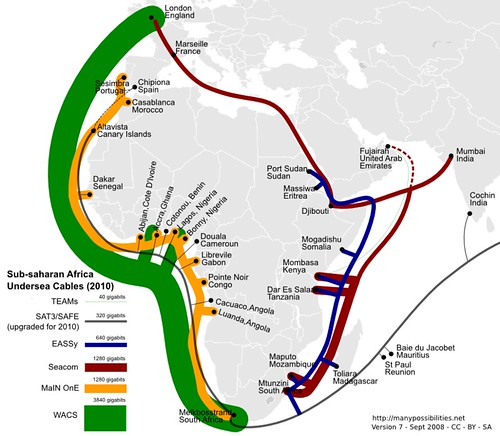
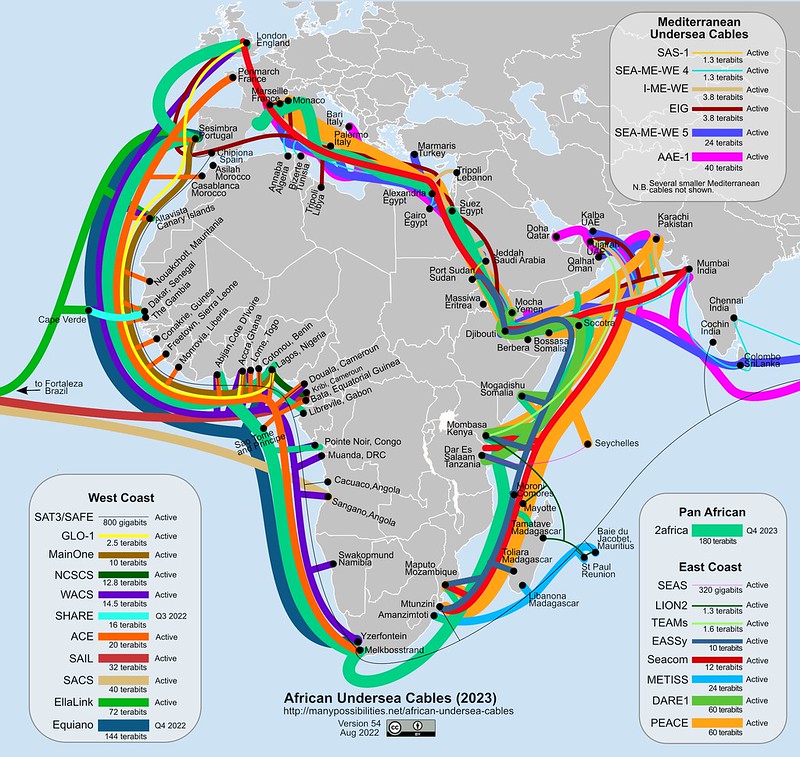
Meanwhile, Ben Roberts, CTO at Liquid Intelligent Technologies, noted in an interview for Global Business that it would take at least a month to find and fix the multiple cable faults on the Western and Eastern coastlines.
[Update 25 March]
Nigeria Seeking Framework to Monitor, Mitigate, and Respond to Future Submarine Cable Outages
The Nigerian Communications Commission has released a statement proposing an “urgent need to set up a framework for joint monitoring, risk mitigation, and emergency response procedures for the submarine cables that pass through the sub-region” and recommending that the West Africa Telecommunications Regulatory Assembly (WATRA) Working Group on Infrastructure “expand its mandate to spearhead the development of a comprehensive strategy to safeguard the subregion’s telecommunications networks and associated infrastructure thereby proactively bolstering resilience through improved disaster response protocols to better insulate ourselves from future disruptions.”
.@NgComCommission Press Release
— Johannes Tobi Wojuola (@Johannxs) March 25, 2024
Nigeria seeks joint West Africa regional protection of undersea cables
Following recent undersea cable cuts that challenged connectivities in many countries in the West Afrcan region, Nigeria has called for a coordinated and multilateral approach…
[Update 1 April]
Cables May not be Repaired Until End of April
Repairs to the damaged cables of West Africa have become a waiting game, with suggestions that all cables may not be repaired until end of April.
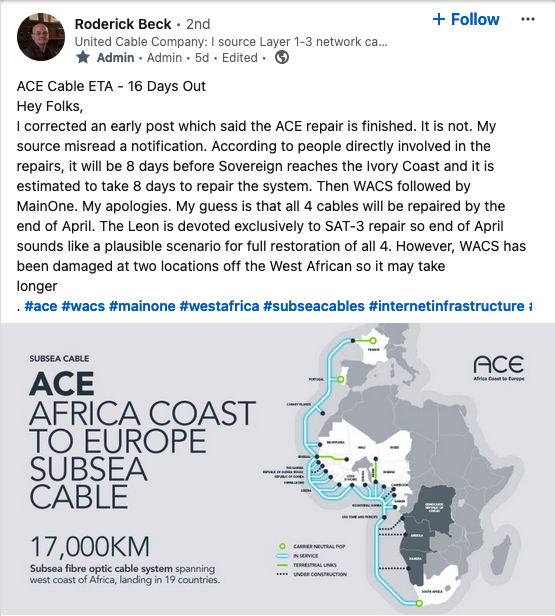
Wired has also provided updates on cable repairs happening in the Red Sea as part of its exposé into the recent damage associated with a sunken ship.
[Update 3 April]
Predicting When Cables Will be Repaired
More assumptions on when submarine cables off the coast of West Africa and in the Red Sea will be fixed.
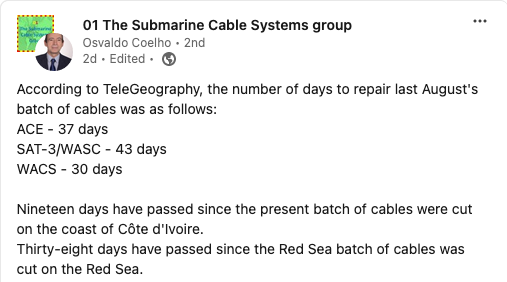
[Update 4 April]
First Cable Repair Ship Arrives
MyBroadband reports that the first of two submarine cable repair ships will arrive at the West African site of one of four major undersea fiber cable breaks on 8 April. A second ship, Global Marine’s C.S. Sovereign, remains en route.
Massive Internet outage — First cable repair ship arrives at quadruple cable break
— MyBroadband (@mybroadband) April 4, 2024
Repairs to key submarine fibre cables off the West coast of Africa are going to take longer than anticipated.https://t.co/RsM2dp8df3
[Update 8 April]
Another West African Submarine Cable Fault?
Cloudflare reports a possible fault with a submarine cable connecting Gambia, Guinea, Liberia, and Sierra Leone.
Possible issue with @acesubmarinec as The Gambia, Guinea, Liberia, and Sierra Leone see significant drops in #Internet traffic between 00:00-01:00 UTC and again at 01:30 UTC on April 8.https://t.co/b6Hvos7rBohttps://t.co/x9Q6TCITjqhttps://t.co/cgT5wW5Zl1…
— Cloudflare Radar (@CloudflareRadar) April 8, 2024
Data from IODA also shows several significant drops in Internet connectivity for each of these countries between 00:00 UTC to 2:00 UTC.
[Update 12 April]
Microsoft Provides Insight to Overcoming Outage
Microsoft has released an incident retrospective detailing how the 14 March events led to the outage experienced by Microsoft’s Azure cloud customers in Southern and Western Africa, which lasted from 14 March 10:33 UTC, until 15 March 11:00 UTC. While Microsoft has invested in redundancy measures that would normally have helped it avoid submarine cable outages, in this case, 3.5 of the 4 paths that they use to connect to the region were affected.
[Update 18 April]
ACE Cable Reconnected!
Internet Society contacts with capacity on the ACE cable have confirmed that the ACE cable has been restored.
Work is still ongoing to repair the remaining three submarine cables, MainOne, SAT3, and WACS.
More to come

